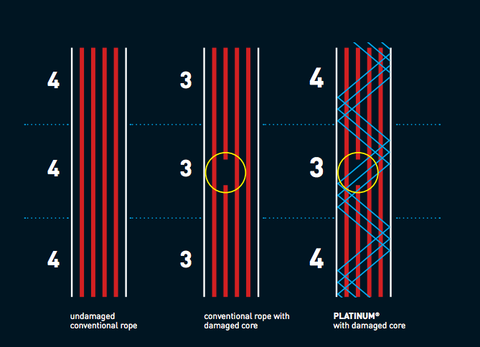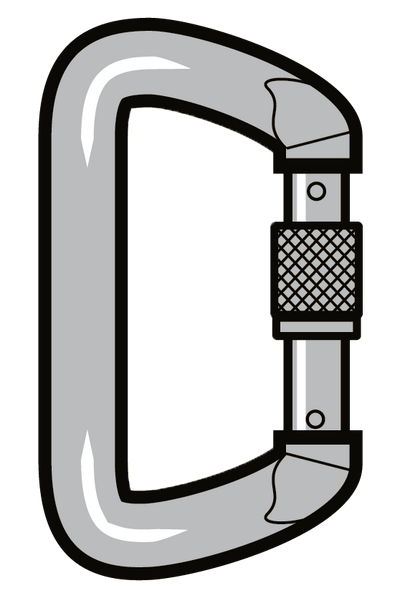Check this out! - Platinum Rope by Teufelberger Rope Co.
New England Ropes / Teufelberger Rope Co. know a thing or two about making the strings we all go work and play with, but it seems they've hit on something really amazing with this latest upgrade. Ladies and gentlemen of the academy, please meet Platinum Rope. Here's what they're doing that got us really excited.
The main idea behind Platinum was to prevent sheath creep. So what they did was change the way they weave the rope. As many of you know, traditional kernmantle rope is built around the idea that the central core of the rope carries most of the strength, while the outer sheath adds a bit of strength but mostly functions to protect the core. The obvious downside to having the load-bearing core separate from the protective sheath is that when under load and bending through a descender, the force causes the sheath to be stretched at a different rate than the core. The end result is that you need to milk your rope a few times and cut off the core-less tails using a hot knife. Clearly not the best option.

With Plantinum, they're now weaving the sheath together with the core, which they refer to it as a "mechanical connection." The big upside is that the sheath can't creep away from the core. The other serious benefit is that any damage to an area of the rope only weakens the rope's strength in that spot, and doesn't weaken the entire length of the rope - a definite bonus. One other thing the new Platinum rope does is allows for a far more supple, flexible rope. To deal with the sheath creep problem, one solution up until now has been to tighten the weave of the sheath. Sure, that reduces sheath creep, but it makes the rope much harder to work with because it's so stiff you need pulleys with a 3 foot sheave! But now that the sheath creep has been eliminated by the new design, you can weave the whole rope to allow for a much softer and flexible feel. Sure it'll still stiffen up if you drag your rope through a bunch of silica dust every day, but the final product is much nicer to work with out of the bag and stays that way longer.


So what's the catch? Well I'd say there are three to consider.
The first and second problems will hopefully go away with time - a lack of NFPA 1983 certification and a lack of 1/2" rope. For any of us in the fire department, that's a problem because we love our 1983 certification and we love our 1/2" rope. So even though Platinum is certified to the EN 341:2011 standard, that doesn't do us a lot of good until we've got some 12.5 mm rope (or 13 mm depending on how you want to round decimal places,) and some NFPA certification to match.
The third catch is the price point. It's a bit hard to compare apples to apples, but 600 feet or 11 mm KM III rope from Teufelberger is about $660, while 590 feet of 11.5 mm Platinum Protect is about $950 (prices in US dollars). That's a 44% price increase! Given that many jurisdictions have a 5 year service life limit on rescue rope, that price increase is likely to translate into purchasing 44% less rope for a lot of smaller fire departments. In fairness, it's a great rope with superior strength and performance, and I expect as Teufelberger is able to increase production on it, we will see that price stabilize at a lower level. Let's hope!
For all of the rabid fans of this blog who happen to work at Teufelberger (because I know you're out there) feel free to add a few more colour options to Platinum too. "Blue-Grey-White" and "Blue-Grey-Yellow" are basically the same coloured rope...Blue-Grey!

All around, this rope is living up to its hype. Teufelberger made some bold predictions about how great this rope would be and in our experience, combined with the reviews people keep giving it, I'd say Platinum can hold its own...and you too!
Stay safe,
- The Dynamic Rescue Team
Also in Blog

Check This Out - Freakin' Beacon
The "Freakin' Beacon"
User feedback was the driving force behind this design, Koehler BrightStar tells us, and it was important to have a product that was lightweight, durable and bright.
Weighing in at just 97 grams (yes, that includes 2x AAA batteries) and less than 7cm long, this unit is amazingly powerful for its small size.

RECOMMENDATIONS FOR DISINFECTING YOUR EQUIPMENT - Petzl
During the current COVID-19 crisis, many of you have sent us questions on how to disinfect your equipment. Here are the basics that you need to know.



